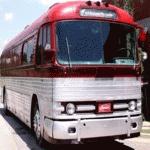| Author | Message | ||
| John Harrelson (Jharl)
Registered Member Username: Jharl Post Number: 98 Registered: 7-2005 Posted From: 74.166.245.86 Rating: N/A |
Hi all it has been a while since I have been here so hello all again. I have a 1964 silver eagle model one that has the the DN 50 alternator (i think that is the model), it also has a 12k diesel Kohler generator. What I want to do is add my CS130 alternator to the generator so that when I am using the generator it will charge the batteries. the bus has a external regulator and the cs130 has an internal regulator. what would happen if the generator and the bus are going at the same time such as down the road? Would the bus bolt come loose? How long would it take to get the fire out? What should I know about regulating both alternators? (Message edited by jharl on September 16, 2010) | ||
| George M. Todd (George_todd)
Registered Member Username: George_todd Post Number: 1103 Registered: 8-2006 Posted From: 12.49.150.202 Rating: N/A |
John, The bus bolt won't come loose if it was properly tightened! What you want to do will work, maybe they both won't charge as fast together as they would seperately, but no big deal. But, does your generator engine have enough horsepower to run both its AC load and a new DC load? G | ||
| Luvrbus (Luvrbus)
Registered Member Username: Luvrbus Post Number: 937 Registered: 8-2006 Posted From: 74.33.38.17 Rating: N/A |
John, mine was wired to a smart charger,charged the batteries on AC power pole or the AC from the generator you can buy those with 3 terminals to charge 3 different banks they just charge the bank that needs the charging good luck | ||
| Austin Scott Davis (Zimtok)
Registered Member Username: Zimtok Post Number: 445 Registered: 9-2006 Posted From: 209.156.24.114  Rating: N/A |
I am with Luvrbus... Use some kind of charger that just runs off the AC the generator is putting out. And it will probably charge when you have the shore power hooked up also. Put a relay inline with the charge cable and then you could disengage the charger when the engine is running. . | ||
| Buswarrior (Buswarrior)
Registered Member Username: Buswarrior Post Number: 1923 Registered: 12-2000 Posted From: 174.89.177.97  Rating: N/A |
Hello John. With two charging sources, they confuse one another. In the applications I have witnessed, the coach system is fooled into showing the "no gen" light. Whether this is hard on anything, others are better qualified to comment, but I don't like the idea of "confusing" expensive and powerful components. However, I am a big fan of redundancy. Having a decent battery voltage alternator, 12v or 24v, mounted on the generator does give you some flexibility when the AC generator head fails, provided you make a work around in your electrical design, that losing 110/220 AC isn't a game stopper. A mixture of alternators, generators, coach engine, pure sine wave inverters, propane, open windows, awnings... without too much trouble, you can have at least two ways to make stuff work. Good idea if using the used parts sources for components. It won't be hard to isolate the various charging sources, once you decide how you are going to use the coach. Either manually or with some circuitry. A generator failure alone is sad, but to ruin the outing and having to run for home crippled... may bring on a hate from the family towards the coach and the designer/installer responsible for another failed vacation. happy coaching! buswarrior | ||
| Gus Causbie (Gusc)
Registered Member Username: Gusc Post Number: 1216 Registered: 11-2005 Posted From: 173.202.47.155  Rating: N/A |
When I had a genset that was hooked to the bus/house battery banks it messed up the bus alternator. This genset had a small alt built into the flywheel because it was supposed to have its own separate battery so it always put out a small charge. It is far better to go the separate AC powered battery charging method whether it is via an inverter or just plug a regular charger into the AC outlet. | ||
| George M. Todd (George_todd)
Registered Member Username: George_todd Post Number: 1105 Registered: 8-2006 Posted From: 99.29.76.160 Rating: N/A |
I said what I said, with some humor, deliberately. BW has it right, they will confuse each other, and IF the bus voltage regulator thinks the batts are fully charged, you may see a no charge light. But it won't do any damage. BUT, the same thing will happen if an AC-DC charger is used, and how big is a 50 Amp 120 Volt charger anyhow??? We still don't have an answer as to whether or not the engine in question has enough horsepower to run a couple of hundred amps of 12V in addition to whatever 120V load is on it. G | ||
| Luvrbus (Luvrbus)
Registered Member Username: Luvrbus Post Number: 941 Registered: 8-2006 Posted From: 74.33.38.17 Rating: N/A |
George, I have a 90 amp 12v Iota charger it has no affect on the charging system it is on a Eagle has a small foot print also. I did it that way because I was always having problems with the inverter charging and it was costing me a fortune shipping it back good luck | ||
| George M. Todd (George_todd)
Registered Member Username: George_todd Post Number: 1106 Registered: 8-2006 Posted From: 99.29.76.160 Rating: N/A |
Well, 1. Whatever we do, DON'T open the output circuit of a charger or an alternator! Sorry I missed that in my last post. 2. A 120-12V charger will vary its output voltage according to conditions, and as I said in my first post: "...maybe they won't charge as fast together as they would seperately..." In other words, if the AC charger sees some output from the belt-driven alternator and lowers it output voltage, the bus regulator will continue to charge somewhat, and all is well. Two engine driven alternators with constant voltage regulators MAY cause each other to produce less output. Probably right after boondocking, with a low battery bank, everything would work well, when things got charged up, then a no-charge light could appear. If the alternator hooked to the generator has its own seperate regulator, a switch in the FIELD circuit would stop the problems. G | ||
| Jim Wilke (Jim Bob) (Pd41044039)
Registered Member Username: Pd41044039 Post Number: 559 Registered: 2-2001 Posted From: 184.0.3.170  Rating: N/A |
Most generator sets are designed so that the engine makes just enough power for full rated load. They do it that way so that you are less likely to burn out the generator end by overloading. If the engine had more power, the gen end would fail but the engine normally stalls or bigs down before the electrical portion is damaged. So if you pull more power off the engine, you will have less AC output available. |